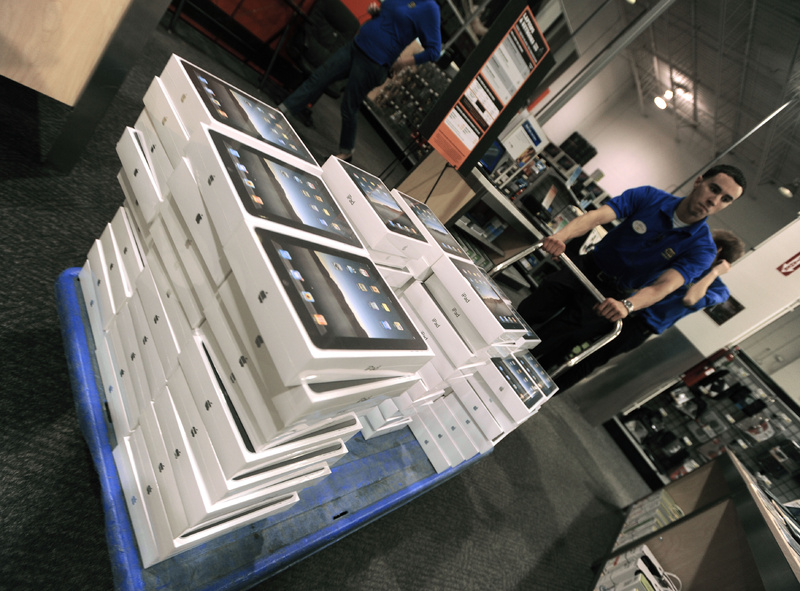WASHINGTON — Consumers spent more and helped lift the economy last quarter but not enough to ignite the recovery and drive down unemployment.
Spending by consumers rose by the fastest pace in three years, the Commerce Department said Friday. That helped the economy grow at a 3.2 percent pace in the January-to-March quarter. It marked the third straight quarterly gain as the United States heals from the longest and deepest recession since the 1930s.
Still, growth was weaker than in the fourth quarter of last year, when the economy grew at 5.6 percent. The first-quarter’s performance would normally be considered respectable in normal times. Yet coming out of the severe recession, more robust growth is needed to drive down high joblessness, stimulate wage increases and lift consumer spending.
Economic growth would have to equal 5 percent for all of 2010 just to lower the average jobless rate for the year by 1 percentage point.
In a Rose Garden statement, President Barack Obama said more jobs are still needed, but he called the quarterly report “an important milepost on the road to recovery.”
Adding more uncertainty to the U.S. economy is the spreading European debt crisis. Greece on Friday heralded drastic new cuts and tax increases to win rescue loans from its European partners and the International Monetary Fund — and avoid a disastrous default on government debt.
Greece, the EU and the IMF are expected to complete talks this weekend over what extra steps Athens must take as a condition of the rescue.
The modest economic growth in the U.S. gave investors another reason to pull back from what has been a hot three months of trading on Wall Street. The Dow Jones industrial average finished nearly 158 points lower.
One bright spot in the Commerce report was that consumers increased spending at a 3.6 percent pace in the first quarter. It was the strongest showing since early 2007 — before the economy tipped into a recession. That marked a big improvement from the fourth quarter, when consumer spending grew at a lackluster 1.6 percent pace.
Shoppers spent more on home furnishings and household appliances, recreational goods and vehicles, clothing and at bars and restaurants.
Looking ahead, analysts say consumers will be wary of stepping up spending much further. The unemployment rate is high at 9.7 percent and is expected to stay elevated in the months ahead. Sluggish income growth and a reluctance or inability to borrow could restrain shoppers’ appetite to spend, they say.
“There are headwinds out there for consumers that probably will restrain growth going forward,” said Joel Naroff, president of Naroff Economic Advisors. “Are those headwinds going to disappear any time soon? My guess is no.”
Naroff predicts consumer spending will slow in the current April-to-June quarter to about a 2 percent pace.
Another report out Friday highlighted one of those headwinds: low wage gains for workers. Wages and salaries, which make up 70 percent of employee compensation, actually slowed in the first quarter. They rose 0.4 percent, after a 0.5 percent gain in the fourth quarter of last year.
Just 21 percent of Americans consider the economy in good condition, according to an Associated Press-GfK Poll conducted April 7-12.
The outlook for moderate economic growth this year means unemployment will stay high — in the 9 percent range — by the November congressional elections. The prospects for high joblessness are a political liability for incumbent Democrats and Republicans.
The first quarter’s reading on gross domestic product was a tad shy of the 3.4 percent growth rate economists were forecasting. GDP measures the value of all goods and services — from machinery to manicures — produced within the United States. It is the best barometer of the nation’s economic health.
Businesses did their part to help the economy grow in the first quarter. Spending by the federal government helped, too.
Spending by businesses on equipment and software rose at a brisk 13.4 percent pace, following an even bigger 19 percent growth rate in the fourth quarter.
The federal government increased spending at a 1.4 percent pace, after being flat in the prior quarter.
Problems in the real estate market slowed economic activity. Builders once again trimmed spending on housing projects, following two quarterly gains. Spending on commercial real estate ventures plunged at a 14 percent pace, the seventh straight quarterly decline. And state and local governments continued to trim spending, a move some analysts expect to continue for years.
Despite pockets of weakness, multiple signals suggest the U.S. economy has turned a corner.
Employers are creating jobs again — a net total of 162,000 jobs in March, the most in three years. Manufacturers are boosting production.
his best bet, Federal Reserve Chairman Ben Bernanke says the economy will log moderate growth.
Copy the Story Link
Send questions/comments to the editors.



Success. Please wait for the page to reload. If the page does not reload within 5 seconds, please refresh the page.
Enter your email and password to access comments.
Hi, to comment on stories you must . This profile is in addition to your subscription and website login.
Already have a commenting profile? .
Invalid username/password.
Please check your email to confirm and complete your registration.
Only subscribers are eligible to post comments. Please subscribe or login first for digital access. Here’s why.
Use the form below to reset your password. When you've submitted your account email, we will send an email with a reset code.